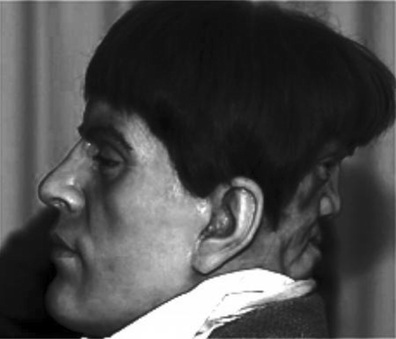Edward Mordake: The Man with Two Faces and the Tragic Legend 👤👤
In the annals of medical history and eerie folklore, Edward Mordake is perhaps one of the most haunting figures—a man born in the 19th century with a mysterious and unusual condition: a second face on the back of his head. Known as the “Man with Two Faces,” his story has captivated imaginations for centuries, blending real medical history with dark legends and eerie tales.
Who Was Edward Mordake?
Edward Mordake was reportedly born in England in the early 1800s, although there is some uncertainty about the precise details of his life. The most widely accepted account places him in the 19th century, though exact dates of his birth and death are difficult to verify. What makes his story so compelling is the alleged presence of a second face on the back of his head, which was said to have a series of horrifying attributes.

This condition, known as craniopagus parasiticus, is an extremely rare congenital anomaly where a second, incomplete body part or face develops, often due to a parasitic twin. In Mordake’s case, the face on the back of his head was fully formed but was reportedly non-functional, lacking the ability to see or eat. However, according to legend, this secondary face had its own disturbing traits—it was capable of whispering, laughing, and even crying.
The Legend of the Face
The legend surrounding Edward Mordake suggests that the face on the back of his head was far more than just a grotesque physical anomaly. Some stories claim that this face was emotionally expressive, capable of making expressions like smiling or frowning, as well as speaking in a low whisper.
The most unsettling part of the legend, however, is the claim that this face would whisper dark, sinister things to Mordake, leading him to be increasingly disturbed by its presence. The whispers, according to some accounts, were taunting and evil, adding to the torment of his already painful existence. He was reported to have described the face as demonic and capable of laughing and crying, even when he himself was not doing so.
Some versions of the story suggest that the face would laugh maniacally in the middle of the night or mutter words that made Mordake feel as if he were constantly being watched by a malevolent force. In other accounts, it’s said that the face was simply a silent, passive presence, but the knowledge of its existence still caused him significant psychological distress.
A Tragic Life and Death
The physical and emotional toll of having two faces on his head would have been overwhelming. In various accounts, it is said that Mordake struggled to find any peace or comfort in life due to his unusual condition, which caused him to live a life of extreme isolation and shame.

The story goes that Mordake sought medical help from several doctors, hoping to rid himself of the second face. Sadly, it’s said that no medical procedure was able to alleviate his condition. The psychological toll of living with such a condition was reportedly devastating, leading Mordake to experience deep depression.
Ultimately, the legend concludes with a tragic end: Edward Mordake is said to have taken his own life at a young age, unable to bear the torment of the face on the back of his head. Some versions of the tale claim that Mordake requested that his body be cremated after death, ensuring that the second face would be destroyed with him.
It’s said that before he died, Mordake reportedly told doctors: “I have a face in the back of my head that never stops whispering to me.” The face, in essence, was a symbol of his eternal anguish, and perhaps his final cry for relief.
The Medical Mystery: Was It Real?
While much of the story of Edward Mordake is steeped in myth and legend, there is some grounding in reality when it comes to the medical explanation. The condition he may have suffered from, craniopagus parasiticus, is extremely rare but real. In this condition, an incomplete parasitic twin forms in the womb but does not fully develop into a separate person. In some cases, a partially formed face or body can be attached to the host individual’s body.
While no documented evidence exists to confirm the existence of Mordake’s second face with all of the supernatural qualities described, the basic medical phenomenon of parasitic twins and conjoined individuals remains an area of interest. One of the closest real-life examples of this condition would be Shannon and Casey Kimbro, conjoined twins who had a partially formed second face that was non-functional.
The story of Mordake, though, has been heavily embellished over time and has taken on more of a folkloric nature, particularly in the way the second face was said to whisper and laugh. It has been described in various medical texts and anecdotes from the 19th century, but the more supernatural elements may have been exaggerated or added as the story was passed down.
A Lasting Legacy of Mystery and Horror
Whether or not Edward Mordake truly had the second face described in the legend, his story remains a fixture in both medical history and pop culture. His tale has been retold in books, documentaries, and even inspired elements in horror films, making him a figure of macabre fascination.
The most significant aspect of Mordake’s story is not just his rare condition, but the way it has captured the imagination of people throughout history. His life and the torment he allegedly experienced embody the universal human fear of otherness, of being marked as different, and of the profound isolation that can accompany such a condition.
The story of Edward Mordake, with its mixture of fact and fiction, has become a modern-day legend—one that evokes a sense of eerie wonder and empathy, as well as the deep sadness of a man who may have lived a life in which he was never truly free from the torment of his own body.
